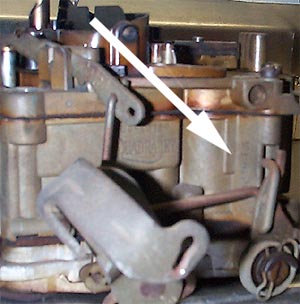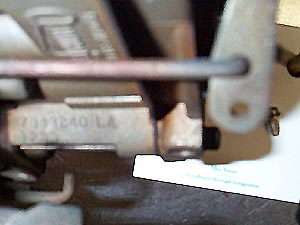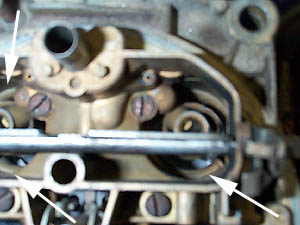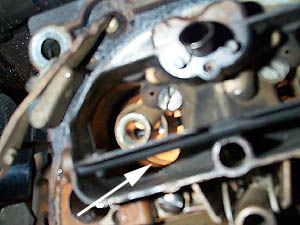
The Rochester carb is the most common carb found in GM cars and trucks from the 1960's to the mid-1980's when they were replaced by fuel injection units. If the carb is maintained properly, it will deliver years of service. There are a few problems with the Rochester carbs as they get older and/or are not maintained.
A common problem is the fuel filter inside the fuel inlet housing becomes plugged with debris from dirty gasoline. This prevents the float bowl from filling quickly and results in poor engine performance. This filter is not an ideal candidate since it is made of paper and can not be seen unless the filter is removed from the housing. The best filter to use is a glass filter connected in-line between the fuel pump and carb. This filter allows you to see if the fuel pump is working as well as if there is any debris in the fuel.
Another problem is the cam that raises the secondary metering rods when the air valves open. This small heart shaped plastic cam is located between the secondary air valves on the air valve shaft. It is common for this part to break preventing proper operation of the secondary air valves leading to a bog.
Another problem associated with the secondary air valves is the vacuum secondary break. This small vacuum break is located on the passenger side of the carb. These small diaphragms rupture after years of exposure to heat and result in the secondary air valves flopping open causing a bog.
A couple of other problems but not common are the carb being bolted to the intake with excessive torque and fuel well plugs leaking. If the carb is overtightened with the four bolts mounting it to the intake the air horn will be bent creating fuel leaks and vacuum leaks. Always change the base gasket when installing a rebuilt carb for it to create an air-tight seal between the carb and intake. The fuel well plugs can leak and the best way to fix them is to use an epoxy to seal both wells. The wells are located under the bottom of the fuel metering rods.
All Quadrajet carbs have numbers stamped on them on the driver's side rear secondary. It is visible when the secondary throttle actuator is opened or the carb is held at an angle. These numbers, 7 digits, indicate what engine the carb is from as well as manual or automatic transmissions, California emissions carb. See photos below for number location.


The sixth digit can be one of the following depending on make: 0,1,2 Chevrolet, GMC or truck 3 Cadillac 4 Buick 5 Oldsmobile 6 Pontiac
YEAR CARB # ENGINE TRANS
---- ------- ------ -----
1967 7027148 400 M
7027146 400 A
7027149 400 w/A.I.R. M
7027147 400 w/A.I.R. A
1968 7028245 350 M
7028244 350 A
7028243 400 M
7028242 400 A
7028240 430 A
1969 7029245 350 M
7029244 350 A
7029243 400 M
7029242 400 A
7029240 430 A
1970 7040245 350 M
7040244 350 A
7040243 455 M
7040240 455 A
7040246 455Stg1 A or M
7040247 455Rivi A
1971 7041245 350 M
7041544 350 A
7041243 455 M
7041540 455 A
7041242 455Stg1 A or M
1972 7042245 350 M
7042244 350 A
7042243 455 M
7042240 455 A
7042242 455Stg1 A or M
1973 7043245 350 M
7043244 350 A
7043243 455 M
7043240 455 A
7043242 455Stg1 A or M
When looking at the jets, you will notice the jet has two digits stamped on the surface. These indicate the diameter of the orifice. For example, 67 indicates a opening with a diameter of 0.067 inch. The part numbers for these are as follows: 7031966 indicates a metering jet with a 0.066 inch opening. Jets run from 66 to 78. So the part numbers will be in the form of 70319xx where xx indicates the number stamped on the jet.
For metering rods, there are two designs-one is a simple taper and the other is a double taper. Rods with a double taper have a "B" after the part number. Rods and jets are interchangeable from 1965-74. In 1975, the Q-jets used have shorter rods and a different taper which is NOT interchangeable with the earlier version. 1975 and up carbs can be identified by the first digit being a one which differentiates these from 1965-74 carbs.
For 1965-7 rods, the part number is as follows: 70318xx where xx indicates the rod diameter at the first diameter change from the rod nominal diameter. Example 7031840 indicates a rod with a 0.040 inch diameter. These were single taper designs. Rods run from 33 to 49.
For 1968-74 rods, the part number is as follows: 70348xx wher xx indicates the rod diameter at the first diameter change from the rod nominal rod diameter. Rods run from 36B to 51B. Remember "B" indicates a double taper rod.
455 engines prior to 1972 used 750 cfm carbs. In 1972 455 carbs were 800 cfm. It is possible that some 1971 455 carbs came with 800 cfm ratings. In order to tell the difference see the pictures below and the decriptions.

